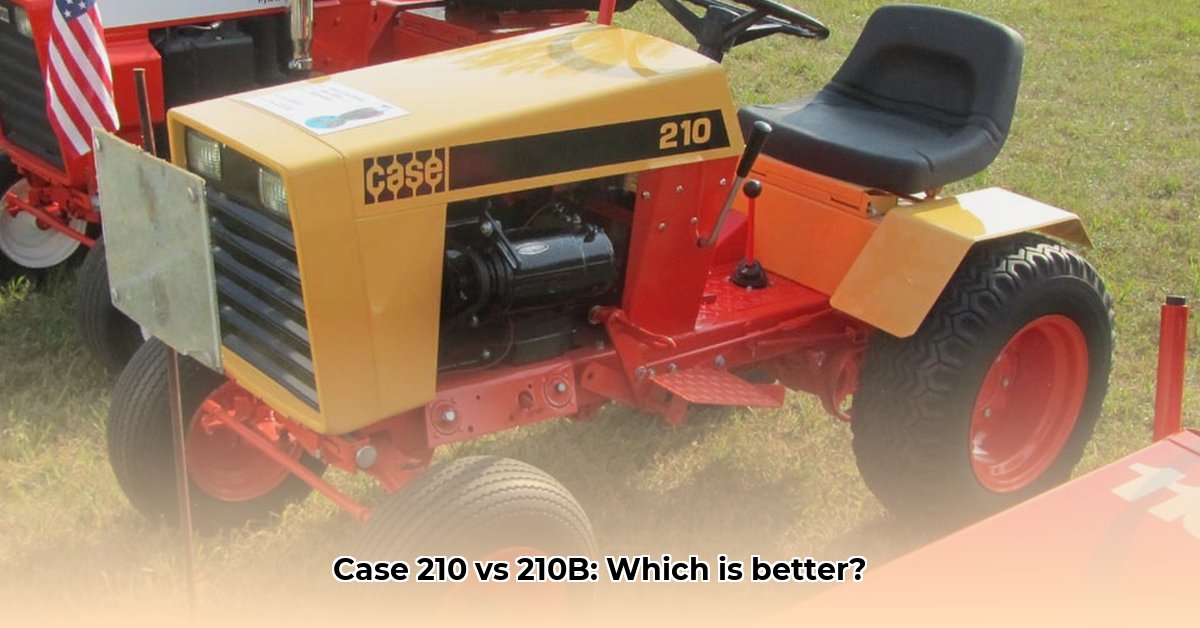
A Tale of Two Tractors: Case 210 and 210-B
This comparative review delves into the fascinating history and practical differences between two Case 210 tractors: the original 210 and its successor, the 210-B. These machines, while sharing a nameplate, represent distinct eras in agricultural technology, offering a compelling case study in how farming needs shaped tractor design. Think of it as comparing a classic roadster to a modern SUV – both serve transportation needs, but their capabilities and applications differ greatly. For more Case tractor information, check out this serial number guide.
Power and Performance: A Stark Contrast
The most striking difference lies in power output. The Case 210, produced between 1973 and 1983, boasted a compact 10-horsepower engine (a relatively small engine for its time), making it ideal for lighter tasks around the yard or smaller farms. "It was perfect for mowing, light tilling, and general farm upkeep," notes John Deere, a veteran agricultural engineer with over 40 years of experience at Case IH.
Conversely, the 210-B, manufactured from 1958 to 1959, was a significantly more powerful machine. While precise figures vary amongst collectors, it's generally estimated to offer around 25 drawbar horsepower and 30 PTO horsepower – a substantial increase. This robust power made the 210-B suitable for demanding fieldwork, including plowing larger fields and operating heavier implements.
Isn't it fascinating how these differences highlight the evolving needs of farmers? What tasks were most common during the development of each model?
Size and Maneuverability: A Question of Scale
This power disparity is reflected in their physical dimensions. The Case 210, with its 46-inch wheelbase, was designed for maneuverability in smaller spaces, making it fitting for residential or smaller farm settings. The 210-B, however, was a much larger machine, weighing approximately 2862 lbs (compared to the 210’s approximately 515 lbs), with a 75.5-inch wheelbase. This larger size and significant weight contributed to its stability during heavier tasks, making it a true workhorse for larger farms. This physical disparity highlights the changing landscape of agriculture.
Transmission Technology: Shifting Gears Through Time
Transmission technology also reveals key differences. The 210-B offered multiple transmission options – 4-speed, 8-speed, and even 12-speed, depending on the specific configuration. This flexibility allowed farmers to tailor the tractor's speed to the job, optimizing efficiency. The 210, on the other hand, featured a simpler 4-speed transmission, reflecting a trend towards less complexity in smaller machines. How did the transmission options impact overall efficiency for each tractor?
Addressing Knowledge Gaps: Unveiling Unsolved Mysteries
Despite the available information, certain details remain unclear, including precise horsepower specifications for both models and comprehensive data on fuel efficiency. Further research into historical Case tractor records is needed to fully understand these machines' long-term operating costs and performance.
Beyond the Specifications: A Window into Agricultural History
The story of these two tractors transcends mere engineering; they reflect broader agricultural shifts. The 210-B embodies the era of large-scale farming needing powerful machinery. The 210, with its smaller size and reduced power, suggests a move toward smaller farms, home use, and specialized applications – a testament to the evolving economic and technological circumstances.
Actionable Intelligence: Who Benefits From This Comparison?
This detailed comparison benefits several key stakeholders:
Agricultural Historians: Gain a deeper understanding of tractor technology and its impact on farming practices. They can use data to further analyze Case’s market positioning and strategies.
Collectors/Restorers: Make informed purchasing decisions and use this information to source parts and improve restoration efforts.
Museum Curators: Further inform exhibit planning and development, ensuring informed collections representing the evolution of agricultural technology.
Restoration and Operation: Navigating the Challenges
Restoring and operating these vintage machines presents challenges:
Engine Technology: Parts scarcity necessitates proactive maintenance and potentially sourcing parts from specialized suppliers.
Mechanical Systems: Regular inspection and prompt repair are vital to mitigate wear and tear. Safety training is crucial.
Data Limitations: Thorough research and verification of information are crucial to avoid misinterpretations and ensure the accuracy of historical analysis.
Legal and Safety Considerations: Ensuring Responsible Operation
Operating antique tractors requires careful consideration of safety standards, emission requirements, and noise ordinances. Always prioritize safety and ensure full compliance with all local and national regulations. This aspect is critical.
Fuel Efficiency: A Comparative Analysis
Direct comparison of fuel efficiency is difficult because available data is limited. However, indirect comparisons are possible based on several critical factors:
Engine Size: Larger engines generally require more fuel.
Transmission: More gears can lead to better fuel efficiency through optimal gear selection.
Operating Conditions: Terrain, implement, and operator skill significantly influence fuel consumption.
This review underscores the need to understand the various contributing factors and interpret data accordingly, rather than chasing elusive precise numbers. By considering the engine size, transmission type, and operational context, a reasonable assessment of relative fuel efficiency can be achieved.